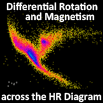Speaker
Mark Miesch
(High Altitude Observatory, National Center for Atmospheric Research, Boulder)
Description
One of the leading paradigms to account for the 11-year solar activity cycle is the
Babcock-Leighton (BL) dynamo model, whereby the principle source of mean poloidal
field is attributed to the destabilization, rise, emergence, and dispersal of buoyant
magnetic flux structures. Though the existence of sunspots and bipolar active
regions is central to the operation of a BL dynamo, their presence is only implicit.
In practical dynamo models of the solar cycle, the complex physical processes that
underlie the BL mechanism are represented as an axisymmetric, nonlocal, poloidal
source term typically formulated as a near-surface alpha-effect that operates on the
deep toroidal field. Here we present a new class of 3D BL dynamo models that more
faithfully captures the essence of the BL mechanism. It is a mean-field dynamo
model but it does not rely on a prescribed alpha-effect. Instead, sunspot pairs
(with tilts in accordance with Joy's law) are explicitly introduced by modifying the
3D near-surface magnetic field in response to strong toroidal fields in the lower
convection zone. The subsequent evolution of these spot pairs due to imposed mean
flows and turbulent diffusion produces a mean poloidal field component as envisioned
in the original work of Babcock and Leighton. This evolution alone is enough to
sustain the dynamo and produce magnetic cycles. The model can be viewed as a
unification of 2D (radius/latitude) BL dynamo models with 2D (latitude/longitude)
surface flux transport models. I will discuss the construction of the model,
initial results, and future plans. I will also briefly summarize complentary
efforts currently underway to clarify the input physics that underly this and other
mean-field models of solar and stellar dynamos.
Authors
Mark Miesch
(High Altitude Observatory, National Center for Atmospheric Research, Boulder)
Mausumi Dikpati
(High Altitude Observatory, National Center for Atmospheric Research, Boulder)

